81
Colour rendering
Light has a significant effect on mood – which is why it
is so important in restaurants that it adapts to natural
daylight, the time of day, and different table arrangements.
The so-called "observer principle" states that we like to
perceive others in brighter light than ourselves.
This creates a protected feeling while making the
surroundings easily recognisable. The lighting design in
the restaurant follows this principle by illuminating table
surfaces more brightly than seats.
Meanwhile, the increased brightness level presents food
appetisingly. Since restaurants are both places to take
time out and work environments, good work light for staff
must be ensured in addition to a unique ambience for
guests. Above-average colour rendering quality (CRI ≥ 90)
is an absolute must in a restaurant. It adds depth of colour
and texture to the dishes and also to the textures of the
walls or upholstered furniture.
Light colour
There is a difference between outdoor lighting with an
inviting and pleasant character, or lighting that conveys a
rather cool ambience. Outdoor lighting rounds off the hotel
and restaurant experience and should also provide an
inviting lighting atmosphere for passers-by.
At a light colour of 2200 K, for example, hotel entrances
look particularly atmospheric. Even 2400 K still conveys a
warm-white atmosphere with a slightly cooler basic tone.
xal.com/knowhow-hotel







